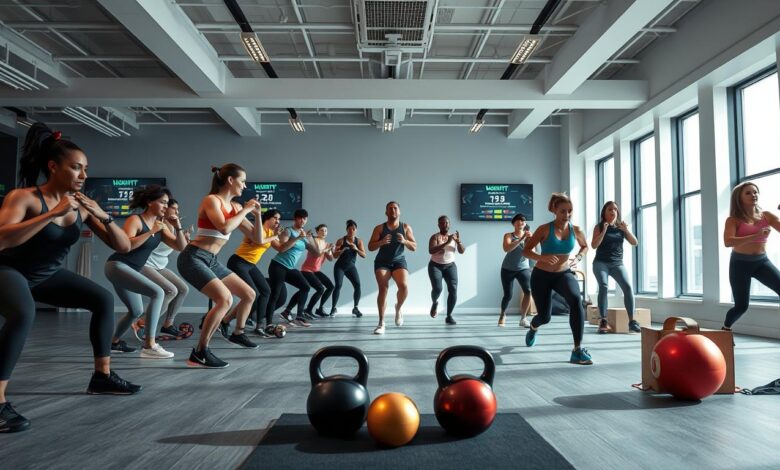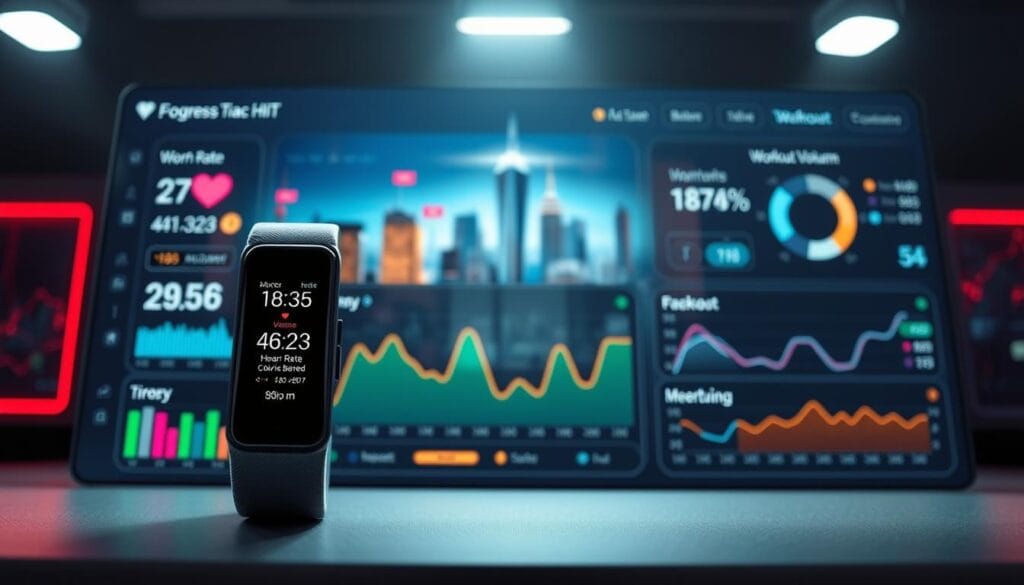HIIT Workouts 2025: The Ultimate Guide to Quick & Effective Training

HIIT workouts have changed the fitness world, and 2025 is taking it even further. This guide shows the top hiit routines for today’s busy lives. They are science-backed and proven to work.
Key Takeaways
- 2025’s high intensity interval training cuts workout time while boosting calorie burn.
- Effective hiit routines now incorporate tech tools for personalized progress tracking.
- Best hiit exercises combine short bursts of maximum effort with strategic rest periods.
- Modern protocols adapt to individual goals, from weight loss to endurance.
- Science shows HIIT improves metabolism and cardiovascular health in as little as 20 minutes daily.
To Help Maintain Healthy Weight & Better Fitness
What Is HIIT? Understanding High-Intensity Interval Training
High-Intensity Interval Training (HIIT) is a workout that mixes short, hard efforts with rest. It burns more calories in less time than regular cardio. By 2025, new tech and science will make high intensity interval training even better for everyone.
The Science Behind HIIT
HIIT starts a process called EPOC (Excess Post-Exercise Oxygen Consumption). This process helps burn calories for hours after working out. Research shows HIIT is 2-3 times better than steady-state exercises like jogging.
Key reasons include:
- Rapid heart rate spikes during intervals
- Increased growth hormone release
- Enhanced fat oxidation
“HIIT’s metabolic benefits are unmatched by few other training modalities,” states the 2024 Journal of Sports Science.
How HIIT Differs from Traditional Cardio
Unlike steady-state running or cycling, high intensity interval training sessions:
| Factor | Traditional Cardio | HIIT Cardio |
|---|---|---|
| Time | 45-60 mins | 15-25 mins |
| Calorie Burn | Primarily during exercise | Continues post-workout due to EPOC |
| Intensity | Moderate steady pace | Alternates 80-95% max effort with rest |
The Evolution of HIIT Through 2025
Recent innovations include:
- AI-driven workout algorithms
- Smartwatches measuring real-time EPOC
- Virtual reality platforms for immersive sessions
These advancements make hiit cardio more accessible while keeping its core intensity.
The Remarkable Benefits of HIIT Workouts
HIIT workouts offer amazing hiit benefits that change your body and mind. These short, intense sessions mix fat burning exercises with strength training. This combo boosts health in ways regular cardio can’t.
- Heart Health: HIIT makes your heart stronger, lowers blood pressure, and improves blood flow.
- Metabolic Power: The intense bursts in fat burning exercises increase calorie burn for hours after, helping with weight control.
- Muscle Maintenance: Unlike steady-state cardio, HIIT helps keep muscle mass while losing fat.
- Time Efficiency: 15–20 minute sessions fit even the busiest schedules.
These routines also sharpen mental focus by reducing stress hormones like cortisol. The mix of explosive movements and rest intervals releases endorphins, lifting mood naturally. Whether you’re a beginner or an athlete, HIIT adapts to your goals, making it a versatile tool for fitness success.
Studies show HIIT improves insulin sensitivity, aiding diabetes management. Plus, the metabolic afterburn effect from hiit benefits ensures your body keeps burning fat long after the workout ends. With such a broad range of advantages, it’s no surprise HIIT remains a top choice for 2025 fitness trends.
To Help Maintain Healthy Weight & Better Fitness
Best HIIT Workouts 2025: Trending Routines That Deliver Results
Get the most out of your time with the best hiit exercises and effective hiit routines leading 2025’s fitness scene. These routines are backed by science, combining new ideas with high intensity. They help you build endurance and strength quicker than before.
Tabata-Inspired HIIT Sessions
Old 20-10 formats are out. Today’s Tabata routines mix it up with 30 seconds of burpees followed by 10 seconds rest. Apps like Strava track your heart rate in real-time to help you burn more calories. For example, try 8 rounds of 45s rowing sprints with 15s rest in between.
EMOM Protocols
EMOM (Every-Minute-On-Minute) workouts build discipline. They mix different exercises every minute. For instance, minute 1 is 15 jump squats, and minute 2 is 20 push-ups. This keeps the workout challenging and prevents getting stuck in a rut.
Hybrid Strength-HIIT Combinations
- Pair kettlebell swings with sprint intervals
- Alternating dumbbell presses followed by 30s plank jacks
- Progressive loading: Add 2.5kg to weights weekly
Tech-Enhanced HIIT Training
Smartwatches like Apple Watch Ultra now work with resistance bands. They adjust the band’s resistance based on your heart rate. AI coaches like Fitbod create effective hiit routines based on your fitness data. This ensures the workout is tailored to your level of intensity.
To Help Maintain Healthy Weight & Better Fitness
HIIT for Weight Loss: Maximizing Fat Burning Potential
HIIT workouts are great for losing weight because they boost your metabolism. They burn fat faster than old-school methods. To get the best results, timing, diet, and slowly increasing the intensity are key. Here’s how to make your plan work for you.

Optimal HIIT Timing for Fat Loss
- Do your HIIT in the morning when you haven’t eaten yet. A 20-minute workout on an empty stomach helps burn more fat.
- Work out for 20–30 minutes, 3–4 times a week. Short bursts of 30 seconds of work followed by 15 seconds of rest increase calorie burning after you’re done.
Combining HIIT with Nutrition Strategies
Match your workouts with a 300–500 calorie deficit diet. Eat enough protein (30g before working out) to keep your muscles strong. Drink electrolyte-rich drinks during your workout. A shake with whey protein and berries after working out helps you recover.
Progressive HIIT Plans
Sample 8-Week Blueprint:
- Weeks 1–2: Sprint for 20 seconds, rest for 10 seconds (repeat 8 times).
- Weeks 3–4: Add burpees or kettlebell swings to work your whole body.
- Weeks 5–8: Increase work time to 45 seconds, rest for 15 seconds, and add resistance bands.
Take rest days with yoga or walking to avoid getting too tired.
HIIT for Beginners: Starting Your High-Intensity Journey
Starting HIIT for beginners doesn’t need top-notch fitness. High intensity interval training (HIIT) fits any skill level if done right. First, learn basic moves before adding speed or harder exercises.
“Consistency builds confidence. Start with 10-minute sessions, then gradually extend duration,” advises Dr. Emily Carter, a sports physiologist at the National Institute of Fitness.
A 4-week starter plan is safe yet progressive. Here’s how to follow it:
| Week | Work:Rest Ratio | Sample Exercises |
|---|---|---|
| 1 | 30:30 | Jumping jacks, bodyweight squats, mountain climbers |
| 2 | 40:20 | Push-ups (knees optional), glute bridges, lateral lunges |
| 3 | 45:15 | High knees, plank shoulder taps, burpees (modified if needed) |
| 4 | 50:10 | Sprints (in place), box jumps (low height), battle rope waves |
- Use a mirror to check form during squats and lunges
- Breathe deeply through mouth during intense efforts
- Rest fully between intervals—no “active recovery” phases
Keep track of your progress each week. See if you can do more reps or rest less. Add dynamic stretches before and foam rolling after your workouts. Don’t compare yourself to others—your journey is unique. Celebrate every small victory, like finishing a session without stopping.
To Help Maintain Healthy Weight & Better Fitness
Equipment-Free HIIT Workouts You Can Do Anywhere
HIIT doesn’t need gym equipment to work. You can do it at home, in a hotel room, or at a park. Effective hiit routines use just your body. They save space, cut costs, and fit any schedule. Let’s look at three types of workouts that keep you intense without any gear.
To Help Maintain Healthy Weight & Better Fitness
Bodyweight HIIT Circuits
Make circuits with classic best hiit exercises. Here’s an example:
- Jump squats (30 seconds)
- Push-ups (20 reps)
- Mountain climbers (45 seconds)
- Plank shoulder taps (30 seconds)
Do it 3-4 times with 10-sec breaks. For less impact, change jumps to lunges.
Apartment-Friendly Low-Impact HIIT
Need a quiet workout? Try this silent routine:
| Exercise | Duration | Intensity |
|---|---|---|
| Wall sits | 45 sec | Moderate |
| Side plank rotations | 30 sec/side | High |
| Tricep dips (chair) | 20 reps | Low impact |
Do 3 rounds with 15-sec breaks. Perfect for small spaces and quiet areas.
To Help Maintain Healthy Weight & Better Fitness
Travel-Ready HIIT Routines
- Minute drills: 30 sec of burpees + 30 sec rest, repeated 5x
- Hotel room ladder: 10 jumping jacks → 8 push-ups → 6 squats (repeat descending)
- Desk core burst: 1-min V-ups followed by 30-sec wall push-offs
These quick workouts fit tight schedules. Focus on fast and effective movements.
Avoiding Common HIIT Mistakes and Injuries
Mastering high intensity interval training is more than just being fast and strong. It’s about avoiding injuries and keeping up the good work. Even beginners and experts can make mistakes that hurt their progress.
To Help Maintain Healthy Weight & Better Fitness
Proper Form and Technique
Doing burpees or explosive moves wrong can hurt your joints. Focus on control, not just speed. For example, do squat jumps slowly before pushing up hard.
Don’t let your back round during deadlifts in HIIT. This can cause long-term harm. Check your posture in mirrors or videos.
Recovery Protocols for HIIT Athletes
- Get 8+ hours of sleep each night to fix muscles
- Use foam rolling after workouts to improve blood flow
- Check your heart rate variability (HRV) with apps to see if you’re ready to train
“Mobility drills like leg swings and thoracic rotations should precede every HIIT session,” advise 2025 NASM guidelines.
Signs You’re Overtraining with HIIT
Look out for muscle soreness that lasts more than 48 hours or a higher resting heart rate. If you’re getting slower, you might be pushing too hard. Take breaks every 4-6 weeks by cutting your HIIT in half.
This balance keeps high intensity interval training a lasting part of your fitness routine, not just a quick fix.
To Help Maintain Healthy Weight & Better Fitness
How to Track Your HIIT Progress and Results
Measuring HIIT benefits is more than just looking at the scale. Keep track of these key metrics to see your progress:
- Work capacity: Record total reps or calories burned in each session.
- Heart rate recovery: Time taken for pulse to drop post-exercise.
- Performance benchmarks: Compare monthly timed sprints or burpees.

Changes in body composition are crucial for weight loss. Here are some ways to measure them:
| Method | Accuracy | Cost |
|---|---|---|
| DEXA Scan | High | Professional facilities |
| Smart Scale | Medium | $100–$300 |
| Progress Photos | Visual | Free |
Use tech tools like Apple Fitness+ or Whoop, along with a journal. “Data without action is just a number,” fitness experts say. Adjust your routine based on trends, not daily changes. Track recovery metrics like sleep quality too. Aim for weekly 10–15 minute review sessions. This way, you’ll fully enjoy the benefits of HIIT and keep up the results from your workouts.
To Help Maintain Healthy Weight & Better Fitness
Conclusion: Incorporating HIIT Into Your 2025 Fitness Strategy
HIIT for beginners is a great way to get fit fast. It’s also great for losing weight. Start by setting your goals, like getting more endurance or losing pounds.
Try new routines like Tabata or EMOM from this guide. They help you move forward. Periodization is key to keep improving. Mix high-intensity weeks with rest to avoid burnout.
Combine HIIT with strength training or yoga for a well-rounded routine. Use apps like MyFitnessPal to track your progress. This helps you adjust your workouts and diet for better results.
Being flexible is important for keeping up with HIIT. Life changes, and so should your workouts. Use bodyweight exercises or shorter sessions when needed. Smartwatches help monitor your recovery, making it easier to adjust.
Future trends like AI will make plans even more personal. But, staying consistent is the most important thing. HIIT is a great choice for 2025 because it’s adaptable. Pick routines that fit your life and goals. Enjoying the process is key to making HIIT a lifelong habit.
To Help Maintain Healthy Weight & Better Fitness
FAQ
What are HIIT workouts and how do they work for weight loss?
HIIT workouts, or High-Intensity Interval Training, mix short bursts of intense exercise with brief breaks. They’re great for losing weight because they boost your metabolism. This means you burn more calories even after you stop working out.
How often should I do HIIT workouts for optimal results?
For the best results, do HIIT workouts 2 to 3 times a week. This lets you recover while still burning fat. Make sure to listen to your body and take rest days to avoid overtraining.
Can beginners do HIIT workouts safely?
Yes, beginners can start with HIIT by doing low-impact and modified exercises. It’s key to listen to your body, slowly increase intensity, and focus on proper form. This helps avoid injuries and enjoy the fat-burning benefits.
What are some of the best HIIT exercises for fat loss?
Top HIIT exercises for fat loss include burpees, high knees, mountain climbers, and jump squats. These exercises raise your heart rate and help in losing weight efficiently. Doing them in a circuit format can make them even more effective.
Can I do HIIT workouts without equipment?
Absolutely! You can do effective HIIT workouts without any equipment. Bodyweight exercises like push-ups, lunges, and planks can be part of a HIIT routine. They’re perfect for those who need easy-to-do workouts at home or on the go.
What are the main benefits of HIIT workouts?
HIIT workouts improve your heart health, burn calories quickly, and help keep your muscles lean. They also boost your metabolism after the workout. Plus, they’re quick, making them great for people with busy schedules.
How can I incorporate nutrition strategies with my HIIT routine?
To get the most out of HIIT, pair it with a balanced diet. Eat foods rich in protein, healthy fats, and complex carbs. Timing your meals around your workouts can also help improve performance and aid in fat burning.
What should I watch out for to avoid injuries during HIIT workouts?
To avoid injuries, keep proper form, listen to your body, and do a good warm-up and cool-down. Start slowly and increase intensity gradually. This helps prevent overtraining and ensures you recover well between workouts.
How do I track my progress in HIIT training?
Track your HIIT progress by monitoring workout duration, intensity, heart rate, and volume. Keeping a log of these metrics shows your fitness improvements. It helps you stay on track with your weight loss goals.


